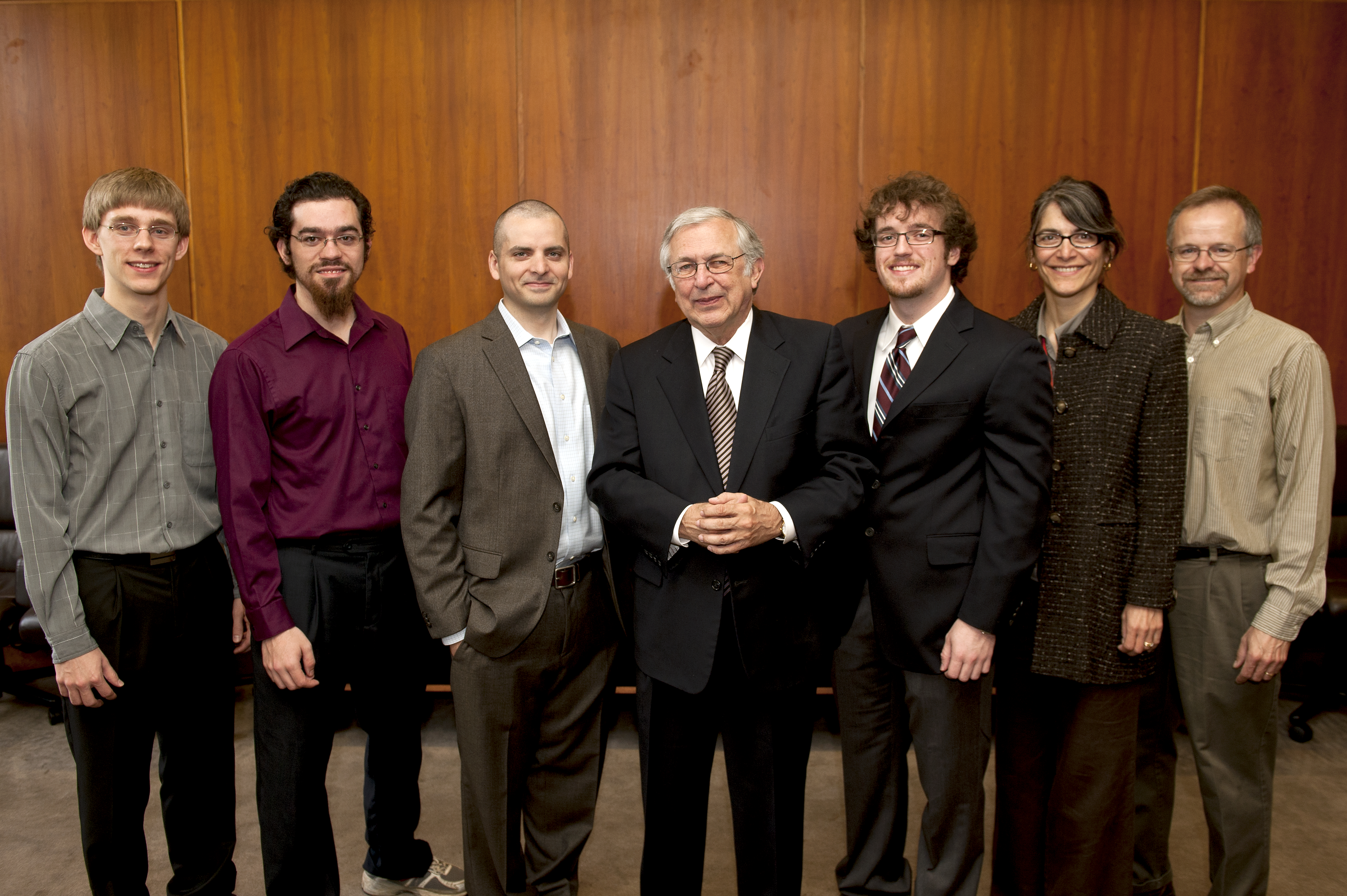Winners of the Charles W. Steger Design Competition recognized

Virginia Tech President Charles W. Steger met with winners of the design competition named in his honor last week and presented them with awards recognizing their exemplary plans for showcasing the dynamic intersection between science, design, and art in the new Virginia Tech Research Center — Arlington.
The Charles W. Steger Design Competition was inspired by the June 2011 grand opening of the research center which represents a significant investment in Virginia Tech’s research mission. The center’s design and infrastructure support the computational research that is being conducted by Virginia Tech institutes and centers housed in the building.
The competition was initiated to garner ideas that Virginia Tech might implement to add visual design elements to the finished interior that would both aesthetically enhance the public areas and promote an understanding of the innovation and discovery taking place in the National Capital Region. The design competition rules instructed contestants to present ideas for enhancing several public spaces in the building, including two lobby reception areas and two hallway display walls in the center’s second-floor executive conference suite.
The jury received a number of excellent entries from students, faculty, and staff representing a wide cross section of programs which include architecture and design, engineering, computer science, and visual arts. Following the judging, competition Chairman James Bohland said that the jury found it difficult to make the distinctions necessary to award first, second, and third place designs as originally planned. “In the end, we decided that two designs, one by a team of students and one by a faculty team, were worthy of first place designation and we would award a third place prize to an individual,” Bohland said.
The two first place teams were awarded $4,000 each; the third place winner received $1,000. Awards for the competition were made possible through a generous gift made by Michele (Shelley) L. Duke in support of the Virginia Tech Research Center — Arlington.
The team of students who took a share of the first place prize worked on the entry as part of a project for their Design of Information class taught by Steve Harrison, associate professor of practice, computer science and School of Visual Arts. The students and their class status at the time of the competition, are:
- Scott Fernandez of Sterling, Va., a senior majoring in computer science in the College of Engineering, mathematics and psychology in the College of Science, and philosophy in the College of Liberal Arts and Human Sciences;
- Joseph Liversedge of Blacksburg, Va., who is taking courses for professional enhancement in the College of Engineering;
- Luke Marrs of Pembroke, Va., a senior majoring in computer science in the College of Engineering; and
- James McIntyre of Hickory, N.C., a senior majoring in computer science in the College of Engineering.
The jury wrote that they were very enthusiastic about the team’s proposal, “especially the multiperspective lenticular images for the display boxes in the two hallways. We believe they represent an extremely innovative means of articulating scientific themes and the interdependencies of creative design and technology. The use of high resolution screens in the meeting spaces provides a method for showcasing Virginia Tech’s science and technologies capabilities.”
In awarding the other first place to “Time Stands Still” by faculty Tom Martin of Blacksburg, Va., associate professor, electrical and computer engineering, College of Engineering, and Paola Zellner-Bassett of Blacksburg, Va., assistant professor, School of Architecture and Design, College of Architecture and Urban Studies, the jury wrote, “We believe the proposal for an interactive textile art piece presents an innovative approach to integrating technology and design. The ability of the design to interact with viewers creates exciting opportunities for further dynamics and the innovative nature of the tapestry impressed the jury.”
Sean MacManus of St. Petersburg, Fla., a master’s student in architecture at the Washington-Alexandria Architecture Center in the National Capital Region, College of Architecture and Urban Studies, took the third place prize for his entry, “Sculptural Identity.” Of MacManus’ entry, the jury wrote that “the design concepts, particularly the dynamic sculpture you propose for the reception area would provide a distinctive image for that space. It would certainly create a space for collective exchange and make the space both a conversation piece and a place for conversation.”
Steger, who served on the eight-person jury, presented the awards during a ceremony in the president’s board room in Burruss Hall. “I am proud of the creativity shown by the Virginia Tech students and faculty as they accepted the challenge to visually merge art and science. The caliber of the winning entries, from a variety of academic disciplines, is a real tribute to the quality of our university programs ranging from science and engineering to the visual arts,” Steger said.
“We are planning to move forward in discussions on how we might implement some of these ideas to enhance the interior and showcase the research and innovation at the Virginia Tech research center in Arlington,” he said.




